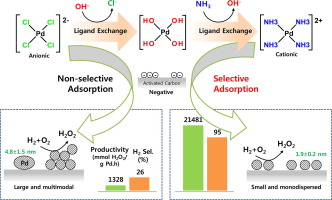当前位置:
X-MOL 学术
›
Mater. Lett.
›
论文详情
Our official English website, www.x-mol.net, welcomes your
feedback! (Note: you will need to create a separate account there.)
An efficient Pd/C catalyst design based on sequential ligand exchange method for the direct synthesis of H2O2
Materials Letters ( IF 2.7 ) Pub Date : 2019-01-01 , DOI: 10.1016/j.matlet.2018.09.068 Seungsun Lee , Young-Min Chung
Materials Letters ( IF 2.7 ) Pub Date : 2019-01-01 , DOI: 10.1016/j.matlet.2018.09.068 Seungsun Lee , Young-Min Chung

|
Abstract A new catalyst preparation method involving the sequential ligand exchange of anionic palladium complexes to cationic complexes via the formation of palladium hydroxide intermediates is proposed. The novel method enables the electrostatic adsorption of an anionic palladium complex on the negatively charged carbon surface, and therefore makes it possible to obtain small and highly dispersed Pd nanoparticles. The H2O2 productivity and H2 selectivity of the ligand-exchanged catalyst were 16 and 3.6 times higher than those of the Pd/C catalyst prepared by using the same anionic palladium precursor. The strikingly different activities mainly attributed to the difference in the nanoparticle size and the oxidation state of Pd, which clearly indicates that the activity of Pd/C catalyst for the direct synthesis of H2O2 can be greatly improved by the sequential ligand exchange method.
中文翻译:

基于序贯配体交换法直接合成H2O2的高效Pd/C催化剂设计
摘要 提出了一种新的催化剂制备方法,该方法涉及通过形成氢氧化钯中间体将阴离子钯配合物顺序配位交换为阳离子配合物。该新方法能够将阴离子钯配合物静电吸附在带负电荷的碳表面上,因此可以获得小而高度分散的 Pd 纳米粒子。配体交换催化剂的 H2O2 生产率和 H2 选择性比使用相同阴离子钯前驱体制备的 Pd/C 催化剂高 16 倍和 3.6 倍。显着不同的活性主要归因于纳米颗粒尺寸和 Pd 氧化态的差异,
更新日期:2019-01-01
中文翻译:

基于序贯配体交换法直接合成H2O2的高效Pd/C催化剂设计
摘要 提出了一种新的催化剂制备方法,该方法涉及通过形成氢氧化钯中间体将阴离子钯配合物顺序配位交换为阳离子配合物。该新方法能够将阴离子钯配合物静电吸附在带负电荷的碳表面上,因此可以获得小而高度分散的 Pd 纳米粒子。配体交换催化剂的 H2O2 生产率和 H2 选择性比使用相同阴离子钯前驱体制备的 Pd/C 催化剂高 16 倍和 3.6 倍。显着不同的活性主要归因于纳米颗粒尺寸和 Pd 氧化态的差异,









































 京公网安备 11010802027423号
京公网安备 11010802027423号